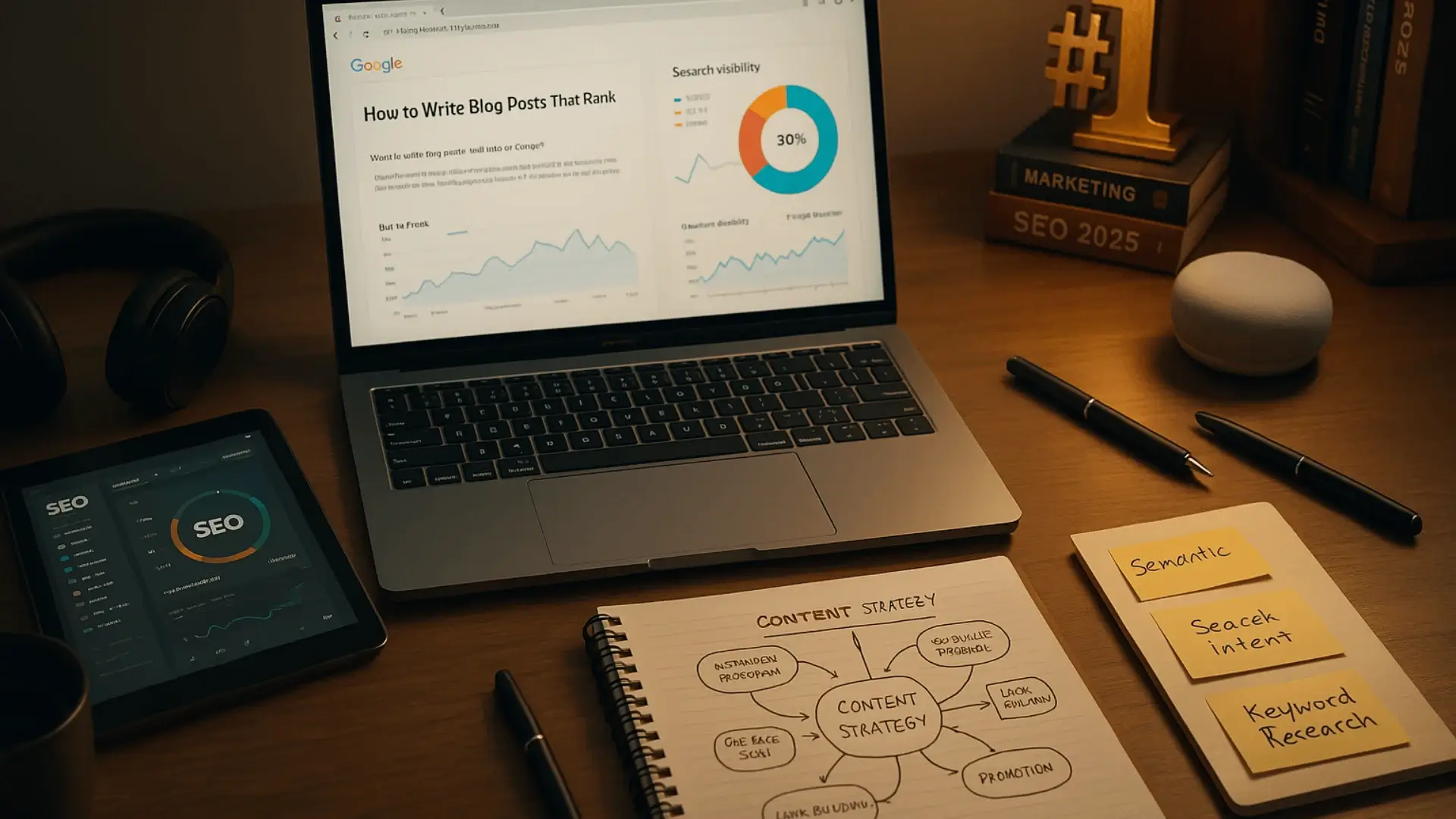How to Write Blog Posts That Rank at the Top of Google (2025 Guide)

Introductions
Want to write blog posts that rank on Google in 2025?
You’ll need more than outdated SEO tricks. This guide shows how to create content that Google truly values — combining smart keyword strategy, technical SEO, and user-first writing.
Success in blog post ranking now means staying ahead of evolving search trends.
Modern SEO relies on strategic content creation, technical expertise, and AI tools to help you write blog posts that rank. This guide will help you write blog posts that rank and become the top choice for both search engines and real users.
Table of Contents
- Why Ranking #1 on Google Matters in 2025
- Understanding Google’s Algorithm in 2025
- Essential Keyword Research Strategies for Top Rankings
- Content Structure to Help You Write Blog Posts That Rank
- How to Write Blog Posts That Rank #1 on Google in 2025
- Mastering E-E-A-T Principles for Authority Building
- Technical SEO Elements for Top-Ranked Blog Posts
- The Role of AI in Creating Ranking Content
- User Experience Metrics That Impact Rankings
- Mobile Optimization Requirements
- Promotion and Link Building Strategies for 2025
- Conclusion: How to Consistently Write Blog Posts That Rank
- FAQ
Key Takeaways
- Master semantic keyword clusters to align with Google’s latest algorithm updates.
- Optimize page speed and mobile performance to increase your chances of ranking first.
- Blend AI tools with human creativity to enhance content quality and avoid penalties.
- Focus on user intent to improve both SEO and engagement metrics.
- Conduct regular technical SEO audits to maintain top-ranking performance.
Why Ranking #1 on Google Matters in 2025
Reaching the top SERP position in 2025 is about more than visibility—it’s a gateway to real business growth. Even as search engine behavior evolves, the benefits of ranking first on Google remain unmatched. Users naturally trust the top result, making it a critical factor in digital success.
The Evolving Value of the Top Spot
Although zero-click searches now account for over 70% of all queries, securing the first position still delivers incredible power. Click-through rates for the #1 result range between 26–32%, far surpassing lower-ranked results.
Traffic and Conversion Statistics for Position #1
- Position #1 drives 10× more traffic than positions 11–20.
- High-intent keywords see a 45% increase in conversions at position #1 compared to #2.
- Local searches convert 3× better when ranked first.
The Zero-Click Search Revolution
Even in today’s zero-click search landscape, ranking #1 still unlocks hidden value.
Featured Snippets and Knowledge Panels are 50% more likely to originate from the top-ranking results.
A 2024 study by Backlinko shows that pages ranking #1 earn 2.4× more backlinks than those in positions #3–10, solidifying long-term authority and trust.
“First-page rankings are the new starting line—position one is the finish line.”
— Google Search Advocate, 2025
Understanding Google’s Algorithm in 2025
Google’s algorithm in 2025 prioritizes content that genuinely meets user needs and aligns with key ranking factors.
The Helpful Content Update favors in-depth guides and problem-solving articles. Here’s how the system works:
- Search Quality Evaluators (SGE): Human reviewers assess content against quality guidelines that directly influence algorithm training.
- Machine Learning: AI systems analyze vast data to rank pages, using insights from SGE reviews to refine what qualifies as “helpful” content.
- Core Priorities: Google now emphasizes relevance, expertise, and user satisfaction over outdated tactics like keyword stuffing.
SEO Ranking Checklist Table: Action Steps to Reach #1 on Google in 2025
| Factor | Impact | Action Steps |
|---|---|---|
| Core Web Vitals | High | Optimize page speed and mobile design. |
| E-E-A-T Principles | Medium | Show expertise with credible sources and author bios. |
| Content Depth | High | Create long-form guides over shallow summaries. |
Watch: How Google Search Actually Works (from Google itself)
Want to understand how Google evaluates and ranks content in 2025?
This official video from Google explains how algorithms, AI, and quality raters shape your search visibility:
“Content should answer questions thoroughly and anticipate follow-up questions.” — Google’s Search Quality Rater Guidelines
Stay Updated with Google’s Evolving Standards
Keep up with algorithm updates like the Helpful Content Update to meet 2025 SEO standards.
Focus on solving real user problems, not just inserting keywords.
Regular insights from Search Quality Evaluators help Google align its algorithm with authentic, helpful content that reflects real-world user intent.
Essential Keyword Research Strategies for Top Rankings
Modern SEO is no longer just about listing keywords.
To rank high in 2025, you need semantic keyword research and a clear understanding of how people search. Let’s explore how to turn keywords into powerful ranking assets.
Semantic Search and Topic Clusters
Google’s algorithms now favor content that reflects real-world knowledge structures.
Create topic clusters by mapping out core themes and their related subtopics.
Tools like Ahrefs or Moz Pro can help you discover semantically related terms, allowing your content to answer user questions more thoroughly.
For example, instead of just writing about “best running shoes,” cover supporting topics such as:
- Materials and design,
- Brand comparisons,
- Injury prevention strategies.
All these subtopics should link back to a central pillar post.
User Intent Analysis Tools
Tools like AnswerThePublic and Semrush’s search intent reports help you understand exactly what your audience is looking for.
Use them to classify keywords based on informational, navigational, or commercial intent.
Creating a search intent optimization checklist ensures that your content addresses the user’s needs before trying to convert or sell.
Competitor Analysis
Uncover keyword gaps by analyzing your competitors.
Tools like SEMrush’s Keyword Gap Analysis reveal terms your competitors rank for but cover only superficially.
Instead of targeting broad terms like “running shoes,” go for long-tail keywords such as:
“how to fix squeaky running shoes”
These are easier to rank for and bring more targeted traffic.
Voice Search Optimization Techniques
To optimize for voice search, target conversational phrases and question-based queries.
Use Google’s “People Also Ask” feature to identify common questions, and answer them in 30 words or fewer to qualify for featured snippets.
For example:
“How do I choose running shoes?”
Becomes:
“Choose running shoes based on foot type, terrain, and support level. Visit a store for a proper fit.”
Also:
- Use Siri or Samsung Bixby to research how people naturally phrase voice queries.
- Focus on “near me” and “how to” terms for local and actionable searches.
“Voice searches expect answers, not ads. Prioritize clarity over keyword stuffing.”
Combine All Strategies
By combining semantic research, user intent, competitor gap targeting, and voice optimization, you can write blog posts that rank in both typed and spoken queries.
This is how you build search engine topic authority in 2025.
Content Structure to Help You Write Blog Posts That Rank
Google rewards blog posts that are clear, well-structured, and follow best SEO practices.
Start strong with an engaging introduction that immediately shows relevance — both to readers and to search engines.
The Perfect Introduction Formula
Your first 150 words should clearly answer the user’s main question. Here’s a simple 3-step plan:
- State the problem or question directly
- Preview 2–3 key solutions or takeaways
- Include your primary keyword naturally in the first paragraph
Example:
“Struggling to rank? Our 2025 guide reveals the three proven strategies top-ranking blogs use — starting with keyword-rich intros that convert visitors into readers.”
Strategic Heading Organization
A logical heading hierarchy improves readability for users and crawlability for search bots.
Avoid skipping levels (e.g., jumping from H2 to H4), and ensure your headings follow a logical flow.Strategic Heading Organization
Use H2 tags to break your content into major sections.
Use H3 tags for subsections within each H2.
SEO Content Format Example
A strong heading structure makes content easy to scan — both for readers and search engines.
Tools like Yoast SEO or Screaming Frog can help analyze and optimize your headings for clarity and hierarchy.
Content Depth vs. Content Length
In 2025, content depth matters more than sheer word count.
A 2024 study by Backlinko revealed that longer, more detailed pages consistently outperform shallow ones — but only when they:
- Address all user intent types: informational, commercial, and navigational
- Include expert citations and credible data
- Answer likely follow-up questions within the post
Use the “3x Depth Test”:
Does your content offer three times more depth than competitors?
If not, expand your key sections and go deeper.
How to Write Blog Posts That Rank #1 on Google in 2025
Start by applying proven Google ranking strategies to write blog posts that rank and make your content stand out.
Choose topics that align with your expertise and your business goals. Use tools like SEMrush or Ahrefs to uncover content gaps in your niche and what users are actively searching for.
Steps to Write Blog Posts That Rank and Get Seen in 2025:
- Run a keyword audit to find long-tail phrases with high intent.
- Optimize each draft by embedding keywords naturally in titles, headers, and body text.
- Apply SEO writing techniques:
- Keep sentences short and clear
- Solve the reader’s problem quickly
- Use headings, bullet points, and visuals for readability
- Write like you’re helping a friend — prioritize clarity, not complexity.
- Enhance credibility with data, expert quotes, and case studies.
- Include images or videos to improve engagement and time-on-page.
💡 Top-performing blog content is 3× more detailed than your competitors’ posts.
Answer more questions — and answer them better.
Optimize Technical Details
- Use primary keywords in your titles and meta descriptions
- Track rankings weekly and adjust based on performance
- Update posts every 6–12 months to keep them fresh and competitive
By following these SEO writing tips, you’ll create content that ranks well and genuinely connects with your audience.
Mastering E-E-A-T Principles for Authority Building
Building content authority in 2025 starts with mastering E-E-A-T:
Experience, Expertise, Authoritativeness, and Trustworthiness.
Google increasingly rewards content that demonstrates real, credible human input.
“High-quality content requires authors with relevant expertise and clear disclosure of qualifications.”
— Google’s Search Quality Evaluator Guidelines
Demonstrating Experience in Your Content
Showcase real-world experience with:
- Case studies relevant to your niche
- Client testimonials with verifiable details
- Content updates reflecting new data or evolving practices
Building Editorial Standards
Consistent quality comes from strong editorial processes. Implement:
- Clear style guides aligned with your niche or industry
- Use of fact-checking tools like SEMrush or Ahrefs
- Monthly content reviews to ensure ongoing accuracy and trust
Trust Signals That Influence Rankings
| Trust Signal | Impact |
|---|---|
| Author credentials (degrees, certifications) | Builds authoritativeness |
| SSL certificates | Ensures secure browsing |
| Third-party endorsements | Strengthens credibility |
Adding these signals boosts rankings while making content feel trustworthy.
Technical SEO Elements for Top-Ranked Blog Posts
Mastering technical SEO makes your blog posts fast, attractive, and Google-friendly. Start with page speed optimization—a slow site loses visitors and rankings. Use tools like Google PageSpeed Insights to identify delays.
Compress images, enable caching, and reduce CSS/JS files. These actions can shave seconds off load times.
Adding schema markup helps your content stand out in search results. Recipes, reviews, or events can earn rich snippets, boosting click-through rates. Use Google’s Structured Data Testing Tool to validate markup without coding.
- Optimize URLs for readability and keywords
- Ensure all links work and redirect broken ones
- Use XML sitemaps to guide search engines
Mobile optimization is crucial. Test layouts on multiple devices with Google’s Mobile-Friendly Test. Ensure touch targets are large enough, avoid pop-ups, and make sure text resizes correctly.
Google’s Core Web Vitals measure loading speed, interactivity, and visual stability. Aim for scores above 50 in all three areas. Use tools like Lighthouse to evaluate performance.
“53% of mobile users abandon sites taking longer than 3 seconds to load.” – Google Core Web Vitals Report 2024
Regular audits help keep your site up to date. Fix errors in Google Search Console and prioritize user-focused improvements. Balancing technical SEO with quality content is essential for top rankings in 2025.
For a deep dive into Core Web Vitals and technical SEO metrics, check out our full guide: Mastering Core Web Vitals: The Ultimate Technical SEO Optimization Guide
The Role of AI in Creating Ranking Content
AI content tools are changing SEO for marketers. But success comes from blending technology with human touch. Google favors natural content that feels authentic. Striking the right balance is essential.
Striking a Balance Between AI and Humans
Effective human–AI collaboration means clear role separation.
AI handles data research and outline drafts, while humans bring tone, storytelling, and brand voice. Tools like Grammarly or Semrush support this workflow.
- AI does: Keyword analysis, outline creation, fact-checking
- Humans do: Storytelling, emotional connection, strategic decisions
Boosting Quality with Content Enhancement Tool
Tools like Wordtune or Royal serve as virtual editors. They suggest ways to improve readability and keyword use. These tools support human input but don’t replace it. Always review suggestions to keep your content original.
“AI isn’t a shortcut; it’s a partner.” – John Mueller, Google Webmaster Trends
Looking for tools beyond Google? Explore 9 Best Pinterest SEO Tools to expand your reach across platforms.
Steering Clear of AI Detection Risks
Google’s AI detection systems penalize excessive AI usage. To avoid this:
- Ensure drafts reflect your brand’s voice
- Avoid repetitive or robotic phrases
- Use manual sources for stats and case studies
Create content that feels human-written. This not only ranks better but also avoids penalties.
User Experience Metrics That Impact Rankings
Google’s 2025 ranking system now heavily weighs user experience signals. Improving page experience means optimizing speed, interactivity, and accessibility.
“User behavior data directly influences search results. Pages with strong engagement metrics and low bounce rates rank higher.” — 2025 algorithm update
Pinterest also offers valuable data insights. Learn how in Pinterest Analytics for SEO.
Core Web Vitals in 2025
Core Web Vitals now include four key metrics:
- Largest Contentful Paint (LCP): under 2.5s
- First Input Delay (FID): under 100ms
- Cumulative Layout Shift (CLS): under 0.1
- Interaction to Next Paint (INP): under 200ms
| Metric | Target | Optimization Tip |
|---|---|---|
| LCP | ≤2.5s | Lazy-load non-critical images |
| FID | ≤100ms | Reduce JavaScript execution |
| Cumulative Layout Shift (CLS) | ≤0.1 | Use size attributes and reserve space for elements |
| Interaction to Next Paint (INP) | ≤200ms | Minimize input delay and optimize thread blocking |
Engagement Metrics Google Tracks
Google’s 2025 algorithms focus heavily on behavioral signals such as:
- Time on page (ideal: 3+ minutes for in-depth content)
- Scroll depth (track how far users scroll)
- Return visits (repeat traffic signals loyalty)
Mobile Optimization Requirements
Mobile usability now requires:
- Touch targets ≥ 48px × 48px for finger-friendly navigation
- Content parity between mobile and desktop versions
- Auto-adjusting layouts for all screen sizes
Combine these page experience improvements with behavioral signal tracking to boost rankings.
Focus on fast loading, easy navigation, and mobile-first design to meet 2025 standards.
Promotion and Link Building Strategies for 2025
Effective content promotion starts with finding where your audience is.
Look for niche forums, industry groups, and online communities. Share your work there to add value without being overly promotional.
Collaborate with influencers who align with your niche to build trust and gain organic backlinks.
“Quality over quantity remains the golden rule. Links earned through genuine partnerships outperform spammy outreach every time.”
— John Mueller, Google Webmaster Trends Analyst
Successful link-building tactics focus on creating content that others want to reference.
Produce infographics, data reports, or interactive tools that people naturally want to share.
Don’t be afraid to ask users to share or cite your work.
Boost social signals by posting when topics are trending.
Use platform-specific content formats:
- Twitter threads for thought leadership
- LinkedIn for B2B engagement
- Pinterest for strong visual appeal
| Strategy | Description | Goal |
|---|---|---|
| Guest Blogging | Write for high-authority sites in your niche | Build relationships + backlink acquisition |
| Broken Link Building | Find outdated content, offer updates, and request links | Passive link building tactics |
| Press Release Optimization | Issue newsjacking announcements via platforms like PR Newswire | Generate digital PR visibility |
Run digital PR campaigns to gain media coverage. Pitch stories that include case studies, original research, or seasonal trends. Include quotes and data to encourage third-party mentions with backlinks.
Once your blog posts start ranking, it’s time to monetize. Start with The Ultimate Guide to Monetizing Your Email List in 2025.
Want to expand your SEO reach beyond Google? Learn how Pinterest search works in The Complete Beginner’s Guide to Pinterest SEO in 2025.
Conclusion: How to Consistently Write Blog Posts That Rank
Building sustainable rankings starts with a solid SEO strategy. This includes keyword research, content depth, and technical optimization. Your blog posts will gain the authority needed to reach the top spot.
Focus on ranking success factors like E-E-A-T principles and Core Web Vitals. These align with Google’s 2025 priorities. Your content optimization workflow should begin with semantic keyword clusters.
Then, structure posts with clear headings and engaging introductions. Use SEO implementation steps like mobile-first design and backlink strategies. Tools like Ahrefs or SEMrush help track your progress.
Sustainable rankings require ongoing updates. Audit existing content for outdated information. Then apply fresh insights from competitor analysis and user intent tools.
When progress slows, revisit your content’s topic clusters or technical performance. Real-world examples show that improving quality and speed leads to better rankings.
Follow a 90-day timeline:
- Month one for keyword audits and content overhauls
- Month two for technical fixes and link building
- Month three for AI-enhanced refinements
Track metrics like dwell time and click-through rates to adjust your strategy.
Remember, top rankings come from disciplined execution — not quick fixes.
If you consistently write blog posts that rank, your content will generate long-term traffic, backlinks, and authority — no shortcuts needed.
FAQ
What are the key strategies for ranking #1 on Google in 2025?
To rank #1 on Google, focus on quality content and keyword research. Also, improve technical SEO and user experience. Use tools to identify user intent and optimize for voice search.
Integrate E-E-A-T principles to build authority and trust. Ensure your content meets user needs and Google’s standards.
How has Google’s algorithm changed in 2025?
In 2025, Google’s algorithm prioritizes high-quality content that demonstrates expertise and trustworthiness.
AI and machine learning help the algorithm understand user intent. Content that clearly answers search queries is ranked higher.
Structured data and mobile optimization are key — they help meet technical standards and improve visibility.
Why is user experience important for SEO?
User experience (UX) affects SEO by influencing engagement metrics.
Improved Core Web Vitals — which measure loading, interactivity, and visual stability — are essential.
Good UX leads to better user satisfaction, encourages return visits, and boosts rankings.
What role does AI play in content creation for SEO?
AI tools help with keyword suggestions and content analysis.
However, you need to balance AI with human creativity. AI can optimize drafts, but human insight is essential for creating engaging, brand-aligned content.
How do I approach keyword research effectively?
Effective keyword research in 2025 means understanding user intent and applying semantic search strategies.
Tools like SEMrush or Ahrefs help uncover overlooked keywords, so you can write blog posts that rank in competitive search results. Also consider voice search optimization and the different search intent types.
What are the best practices for content structure that enhances SEO?
A clear and organized content structure is vital for SEO. Start with an engaging introduction and use H1–H6 headings to guide readers.
Use bullet points and numbered lists to enhance readability. Ensure the depth of your content matches user queries to satisfy both readers and search engines.
How can I build backlinks sustainably and ethically in 2025?
To build backlinks ethically, create valuable content that earns links naturally.
Engage in digital PR, guest blogging, and expert collaborations. Build real relationships and offer helpful resources or insights.
This approach builds authority without manipulative tactics and improves your standing in Google’s eyes.
What are Core Web Vitals, and why do they matter?
Core Web Vitals are key user experience metrics — they measure loading performance, interactivity, and visual stability.
They matter because they directly affect your Google rankings.
Meeting these benchmarks ensures a smooth browsing experience and encourages higher engagement.
What is the importance of E-E-A-T in content creation?
E-E-A-T stands for Experience, Expertise, Authoritativeness, and Trustworthiness.
These are essential for Google’s content evaluation process. Demonstrating E-E-A-T through research, real-world examples, and credible sources boosts your content’s credibility — and your chances of ranking higher.
See how SEO strategies lead to real results in How I Created a 5-Figure Passive Income Blog Using Bluehost.








